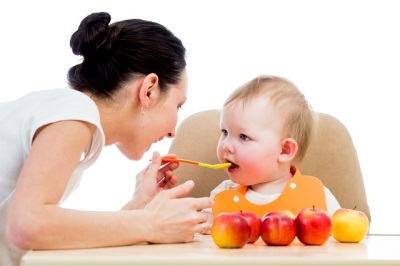Prikorm on Komarovsky
In the first months of life, the baby needs only mother's milk or, in case of impossibility of breastfeeding, an adapted mixture. An older toddler already requires an expansion of the diet, which is called complementary foods. Let's consider the introduction of complementary foods to the diet of babies of the first year of life from the position of the famous pediatrician E. Komarovsky.
Differences of supplementary food and feeding
These two words can cause confusion because of the similarity, but they mean different things. If the infant does not have enough mother's milk and is given either an infant formula, or animal milk, or the milk of a female donor, then such food is called supplement. In this case, feeding a baby is called mixed. Those products that give the baby in the first year of life, as an addition to breast milk or a mixture, are called complementary foods. They are designed to teach the baby to adult nutrition.
Early lure - benefit or harm?
Young parents are faced with advice from friends, relatives and even health workers to start feeding up much earlier than the times recommended by modern medicine. The older the baby becomes, the more often it will sound recommendations to give the baby juice, yolk, mashed potatoes and other foods.
Modern parents should understand that early introduction of complementary foods in the past was mainly due to the fact that crumbs were rarely breastfed, and breast milk substitutes were deficient.

Most often, the little ones were given the diluted milk of the cow that was boiled. Vitamins in such nutrition were destroyed and the baby received a lot of nutrients. And in order to fight hypovitaminosis, lag in weight gain and development, anemia and other problems, recommendations were created to give juices, yolk slices, vegetable puree from the first month of life. Also, let's not forget that the sale of juices, various cereals, mashed potatoes and other baby food is quite a serious business. Therefore, the marks on the packages that the product can be given from three or four months are advantageous, first of all, to manufacturers.
Nowadays, if a nursing mother eats in a balanced and varied way, or the crumb gets an adapted mixture as a substitute for mother's milk, there is no need to feed the baby under 6 months. If the crumb is smaller, it makes sense to focus the efforts of the parents not on the introduction of complementary foods, but on improving the nutrition of the mother or buying a quality mixture.
The benefits of earlier feeding the baby with other products besides milk or a mixture are almost absent, but many parents can see the harm. First of all, these are allergic reactions and digestive disorders. Therefore, the question of the start time of feeding should be considered by parents in a very detailed and balanced way.
Introduction Rules
- Any new food product to be included in the diet of the baby should be very carefully and gradually. We start with one sip and one spoon, after which we feed our usual food (breast milk or formula). After evaluating the reaction - stool, sleep, skin condition, behavior - the dose can be increased.
- If something is alerted, the product should be postponed.
- In the case when painful manifestations have appeared, new products cannot be introduced before they disappear.
- Do not give a baby a new product during illness, as well as during the period before vaccination (3 days) and after it (within 3 days).
- If the baby refuses some product, it is not necessary to insist.

What product to start feeding?
Opinions of nutritionists and pediatricians regarding the group of products, which should be introduced into the diet of the baby first, are very different. Supporters of the introduction of the first puree of vegetables claim that they are rich in mineral salts, as well as vitamins. Supporters of fermented milk foods say that the kids react badly to drastic changes in the diet, and fermented milk products differ from milk much less than vegetables.
Complementary feeding strategy for Komarovsky
Entering lure during natural feeding and feeding the mixture is the same. The well-known pediatrician offers a practical approach to the introduction of a new food in the baby’s menu, which helps to prevent the child’s unwanted reactions to the new food to the maximum:
- If the child is not yet five months old, he does not need any lure. You should take care of the quality nutrition of the mother, and if there is not enough milk in her mother's breast, then provide the baby with a good adapted mixture.
- At five months, babies start to lure, who lose weight poorly, as well as with low hemoglobin. If the baby is healthy with development as well as development, then the beginning of complementary feeding is transferred for 6 months. Also a little later, it is worth starting to lure babies who have had food allergies or used special mixtures.
- You can start with a fermented milk product like kefir. The most optimal product will be designed for baby food. We will introduce it into the second feeding, which occurs between 9 and 11 am. This product will not only be absorbed better than other foods complementary foods, but will also provide the baby's body with useful lactic acid bacteria.
- For the first time, three or four teaspoons of kefir are enough. After him, the child needs to give her mother's breast or a bottle of the mixture. Watching the baby until the end of the day, we immediately notice whether it is possible to increase the dose. Making sure that everything is normal, the amount of kefir is doubled the next day. It turns out that on the first day the baby will receive from 15 to 20 ml of kefir, on the second day already from 30 to 40 ml, on the next day - from 60 to 80 ml, and on the fourth day a full portion from 120 to 160 ml. In the event that something has changed with the baby and the mother suspects kefir in this, we pause. The dosage of the product is not increased, and sometimes even reduced.
- From the fourth or fifth day you can add cottage cheese to kefir. It can be a purchased product, or made by yourself. For the first day, one spoon is enough; on the second day, give two spoons. So gradually increase the amount to 30-40 g for a child of 6-8 months. Both kefir and its combination with cottage cheese can be sweetened with sugar. It all depends on the taste of the original product and the desire of the baby to have a product without sugar.
- During the week, one feeding will be replaced by a mixture of kefir (150 ml on average) and cottage cheese (30-40 g) completely. In all other feedings, the baby will continue to receive breast milk or formula. Support this mode for another 3-4 weeks, after which we proceed to the replacement of another feeding.
- The next feed, in which we will introduce feed, it is better to choose the latter (feeding before bedtime). We will introduce porridge into it, preferably buckwheat, rice or oatmeal. Porridge can be both cooked mom independently from flour, and bought in a store. Cook porridge in milk (ordinary cow), although the best choice would be mixtures for babies older than six months. Insofar as semolina is a source of gliadin protein and is capable of causing intestinal diseases with intolerance, it is advised to enter into the diet of a child after eight months.
- By 8 months, the baby will be completely replaced two feedings. He receives kefir and cottage cheese in one feeding, in another porridge, and several more times the mixture or milk from the mother’s breast. You need to find out if the baby has at least one tooth. If there is a tooth, we will introduce vegetables. For the trial feeding vegetables cook the baby broth. Crush carrots, potatoes, cabbage and onions, pour boiling water (about 50 grams of vegetables will need about 100 grams of water), close the lid and cook until the vegetables are completely melted. Strain the broth, boil it again and pour it into the bottle. This broth on the first day we give the child from 30 to 50 g, on the second day - twice as much.
- If the baby reacts well to vegetables, we start giving soup or mashed potatoes, also increasing the dosage constantly until a single feed is replaced. For mashed potatoes, stew various vegetables in boiling water, then wipe, add a little salt and hot milk (25 ml per 100 g of vegetables), then you need to beat them and bring them to a boil again. In the finished puree you need to add 3 g of vegetable oil.
- After two or three weeks of feeding vegetables try to introduce meat. Instead of water in vegetables, add meat broth (preferably chicken), then add to the soup or puree the meat, which will be in a shabby state. A few days later, in the same soup, or in mashed potatoes, you can add 1/5 of the yolk from a chicken egg, which is hard boiled.
- Fruits also begin to enter after the appearance of the first tooth. If there are no teeth yet, give the babies juice. They are used as an adjunct to formula or breastfeeding and are not intended to replace feeding. Older children can add fruit to the porridge, give the fruit puree, and suck on large pieces.
- By 9 months the supplement will already replace 3 feedings. In one of them, the baby gets porridge, which can be very different. In another feeding baby give soups or vegetable dishes with the addition of any lean meat, as well as yolk and vegetable oil. After feeding the baby gets the juice. Another feeding is kefir with curd, to which you can already add baby food. biscuit. At this time, the child can offer a piece of bread, and from 10 months of age, to use soup for cooking soup, not meat, but fish broth.
Lure and health
When parents experiment with baby food, they should always remember about the health of their baby. The older the baby is, the easier it will bring innovations to the menu. With products that do not grow in your region and are not typical for the diet of your region, you should be very careful.
It is also important not to forget that in babies the liver is a rather weak and vulnerable organ. She fully "ripens" only at the age of twelve. And because the products to which the child had a reaction before, as the liver matures, they begin to be perceived by the baby normally. As the grandmothers say, the child "outgrows". So if your child reacts negatively to chocolate or tangerines, this does not mean that he will have to refrain from these products all his life.
For more information about all these nuances, see the transfer of Dr. Komarovsky.



























































